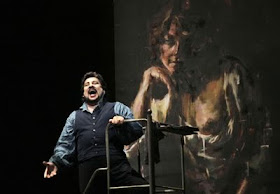 Marcelo Álvarez as Cavaradossi at canvas of Mary Magdalen, Tosca, directed by Luc Bondy, Metropolitan Opera, 2009 (photo by Mary Altaffer/AP) |
Tosca [was] presented in a gala evening before a trendy audience (where furs, haute couture gowns, and altered noses were in abundance), causing a terrible stir, a vengeful booing from the heart of an audience furious that "its" Tosca had been taken away. The one it has seen on the Met stage since 1985, concocted by the Italien Franco Zeffirelli. Because the Met audience, or at least its noisy majority, wants a Tosca in CinémaScope, with its Baroque church in the first act, its Palazzo Farnese in the second, and in the third its Castel Sant'Angelo, with that impossible view of St. Peter's and the Vatican. One suspects that many in the audience have never visited Rome, read the libretto of Luigi Illica, or read the play by Victorien Sardou, but, offended, they want a Tosca in line with how they picture it, and that's what they pay for.No mention of the technical problems that spoiled the opera's dramatic conclusion. Machart does note that this is the first season at the Met completely under the Gelb aegis and that it is "a season marked by novelty (nine new productions, a number last attained in 1966) and audacity because he is bringing to New York some European directors who have never mounted an opera there, notably Patrice Chéreau and Luc Bondy." Perhaps Martin Bernheimer had the best criticism of the production, admitting first that he loathed that tired, old Zeffirelli production before also admitting that he loathed Bondy's version just as much.
It is true that Zeffirelli's production is the exact opposite of that made by Bondy and his talented designer, Richard Peduzzi. In visual contrast with the Italian and his orange sunrise in Act III in particular, Bondy preferred a simple tower and a sky of an opaque blue-gray, the color of blueness in one's soul, the tint of despair in a condemned man. Above all, he has transcribed the exact color of Puccini's orchestra at the moment of the bells that announce Cavaradossi's execution, the hue that the libretto describes as "a light uncertain and gray" (la luce incerta e grigia che precede l'alba). Therein lies the problem: the opera audience often takes false traditions as primary truths and confuses abusive reinterpretations (they are legion, it is true, on operatic stages) with respect for the letter of the law. One saw spectators getting offended that Tosca, in Act II, sang her famous aria Vissi d'arte seated on a sofa. But what does the libretto say? "Tosca falls, spent, on the couch" (Tosca affranta dal dolore si lascia cadere sul canapè).
A wave of indignation was perceived when, in Act II of this production in 19th-century costumes, Art Deco furniture appeared, suggesting with elegance and discretion that Scarpia, the chief of police, had some traits in common with Mussolini. Is it so wrong to show Scarpia with three prostitutes when he says, literally, that he wants to have a taste of different wines and different women (Dio creò diverse beltà e vini diversi... Io vo' gustar quanto più posso dell'opra divina!) and when Sardou, in his play, denounces the morals of this "filthy satyr," bloodthirsty even in his orgies?
Boy oh boy am I getting tired of reading that the reaction on Monday night was due to New York's old-fashioned tastes and resistance to change. No: Zeffirelli's production was tedious and bloated; Bondy's tedious and spartan, with more than enough moments that made one feel Bondy's interpretation was not audacious and informed, but simply cavalier.
ReplyDelete"a season marked by novelty (nine new productions, a number last attained in 1966)
ReplyDeleteCharles, a footnote here would be that those nine new MET productions of 1966-67 included the world premieres of Samuel Barber’s Antony and Cleopatra and Marvin David Levy’s Mourning Becomes Electra -- both American operas.
Perhaps this is a case of plus la change plus la meme.
ReplyDeleteIn the late '70s, I saw what must have been the predecessor production to Zefferelli's twice, possibly three times. Sadly, I don't remember anything about the singers, but I do remember what the production looked like: and the third act sky was very much a blue gray affair; and I'm pretty sure that Tosca, while not sitting on the sofa, clung to it for support during Vissi d'arte, during at least one of those performances. (I think in one of the other performances, the singer, whomever it was, sang the aria kneeling on the floor.)
BTW, do you know of any online archive that would prod my memory of who the singers were in these and other productions of that era? These were the operas the Met toured with every spring after the New York season; they spent a week in Atlanta, which is where I saw them.
(Word verification: sings)